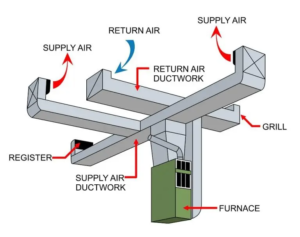HVAC ducts are sized based on a specific calculation that considers several factors:
- Cubic Feet per Minute (CFM): This measures airflow volume. Larger areas needing more airflow will require larger ducts.
- Friction Loss: Airflow loses pressure as it travels through ducts due to friction from bends, elbows, and length. Duct size should account for this loss to maintain adequate airflow at the vents.
- HVAC Unit Size: The size (measured in tons) of your furnace or air conditioner determines the total CFM it can handle. Larger units need larger ducts.
Due to these complexities, determining the appropriate duct size is best left to an HVAC professional. They can perform the necessary calculations and account for your specific home’s layout, square footage, and desired temperature control.
However, if you’re curious about the general range of HVAC duct sizes, here’s a ballpark idea:
- Rectangular ducts: Typically range from 3 x 7 inches to 35 x 40 inches.
- Round ducts: Diameters typically range from 4 inches to 41 inches.
Remember, this is just a general range, and the actual size needed for your home will vary. It’s always best to consult with a qualified HVAC professional for proper sizing and installation.

Here are some unique short focus keywords you can use for “How big is HVAC duct?” that emphasize the need for professional assessment:
- HVAC duct size: Don’t guess, call a pro! (Highlights the importance of professional sizing)
- Big ducts, small ducts? It depends on your space (Focuses on the role of conditioned space)
- Perfect duct size? Match airflow, not just size (Emphasizes airflow requirements over just physical dimensions)
Consult with an HVAC professional Vipul Ac or Contact +91 8000090000 to ensure optimal efficiency and comfort in your home.
